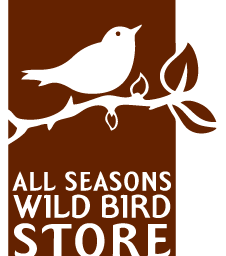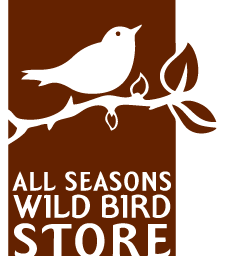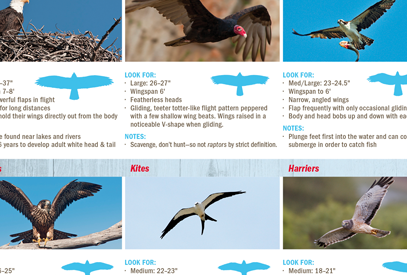A raptor, also known as a bird of prey, is a carnivorous, meat-eating bird. All raptors share at least three characteristics: keen eyesight, eight sharp talons and a hooked beak. The word “raptor” comes from a Latin term rapere meaning “to seize or grab.”
Minnesota raptors include eagles, falcons, hawks, kites, osprey, owls and vultures. Most Minnesota raptors have plumage in some combination of earth tones to better blend in with their environment: light to dark brown, black and white or grayish blue. The following is an introduction to identifying some of Minnesota’s more prevalent birds of prey.
KEY FEATURES FOR IDENTIFYING RAPTORS
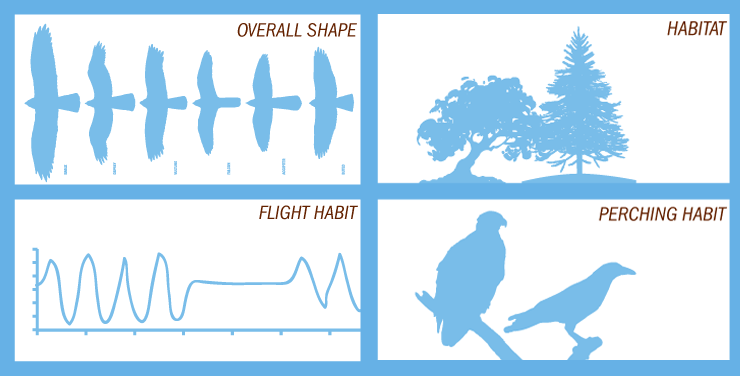
Identifying raptors can be a tricky undertaking. For one thing, juvenile birds don’t look like parent birds for at least a couple years
Another complication: male and female birds of prey most often look identical, with only size to distinguish between the two (the female is typically larger than the male!).Complications aside, there are some key features you can look for when attempting to identify a raptor:
Overall Shape. Note the overall shape of the bird—shape of the head, wings, tail and body.
Flight Habits. Does the bird use “active flight”—meaning flapping wing beats—or does it primarily soar, glide or hover?
General Habitat. Look at the general habitat and determine if it would be considered prairie, woodlands or roadside.
Perching Habits. In general, perching raptors sit upright, whereas non-raptors, such as crows, lean forward over their feet.

Bald EagleLOOK FOR: • Large: 31–37″ • Wingspan 7–8′ • Deep, powerful flaps in flight • Can soar for long distances • In flight: hold their wings directly out from the body
NOTES: • Tend to be found near lakes and rivers • Takes 4–6 years to develop adult white head & tail |

Turkey VultureLOOK FOR: • Large: 26–27″ • Wingspan 6′ • Featherless heads • Gliding, teeter totter-like flight pattern peppered with a few shallow wing beats. Wings raised in a noticeable V-shape when gliding.
NOTES: • Scavenge, don’t hunt—so not raptors by strict definition. |

OspreyLOOK FOR: • Med/Large: 23–24.5″ • Wingspan to 6′ • Narrow, angled wings • Flap frequently with only occasional gliding • Body and head bobs up and down with each pump
NOTES: • Plunge feet first into the water and can completely submerge in order to catch fish |

FalconsLOOK FOR: • Varies: 16–25″ • Long, tapered wings and small bodies • Active fliers, seldom glide • Able to hover, change direction quickly and reach incredible speeds when diving
NOTES: • Minnesota hosts American Kestrel, Gyrfalcon, Merlin, Peregrine Falcon, and Prairie Falcon |

KitesLOOK FOR: • Medium: 22–23″ • Slim bodies with long falcon-like • Active fliers—bouncy without much gliding—
NOTES: • Minnesota hosts the Swallow-tailed Kite* (*shown) • Feeds mainly on snakes • Prefers wooded river swamps and pine lands |

HarriersLOOK FOR: • Medium: 18–21″ • Slim with long, narrow, round-tipped • Smooth, full wing beats with sudden drops to the ground to pounce on prey • Fly extremely low to the ground along landscape
NOTES: • Minnesota hosts Northern Harriers • Wings are slightly raised in a V shape when gliding |

Buteo-type HawksLOOK FOR: • Varies: 15–24″ • Broad wings, wide, rounded tail • Slow, heavy flaps for 3–6 beats followed by gliding • Gain altitude by flying in consecutive tight circles until high enough to soar
NOTES: • Minnesota hosts Broad winged, Red-shouldered, Swainson’s, Red-tailed*, Rough-legged and |

Accipiter-type Hawks (“Bird Hawks”)LOOK FOR: • Small to medium: 10–26″ • Short, rounded wings • Slender bodies and long tails • Flight is burst of quick flutters and a glide • Compacted size equips them for rapid maneuvering around trees in pursuit of small birds
NOTES: • Minnesota Hawks in this grouping are Cooper’s*, Sharp-shinned, Northern Goshawk (*shown). |

OwlsLOOK FOR: • Size varies widely by species • Flattened facial disk with large, forward-facing eyes • Nocturnal; perch during the day. • Flight is noiseless, “mothlike” • May have ear-like tufts
NOTES: • MN: Great Gray, Snowy*, Barred, Barn, Northern Hawk-Owl, Burrowing, Boreal, and Northern Saw-Whet Owls (no tufts); Great Horned, Long-eared, Short-eared and Eastern Screech Owls** (tufts) |
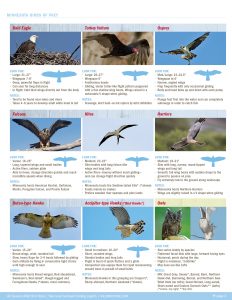
By Minnetonka Manager CAROL CHENAULT
Reprinted from our Bird’s-Eye View archives from March/April 2013
